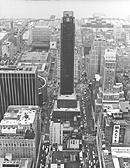All Nonfiction
- Bullying
- Books
- Academic
- Author Interviews
- Celebrity interviews
- College Articles
- College Essays
- Educator of the Year
- Heroes
- Interviews
- Memoir
- Personal Experience
- Sports
- Travel & Culture
All Opinions
- Bullying
- Current Events / Politics
- Discrimination
- Drugs / Alcohol / Smoking
- Entertainment / Celebrities
- Environment
- Love / Relationships
- Movies / Music / TV
- Pop Culture / Trends
- School / College
- Social Issues / Civics
- Spirituality / Religion
- Sports / Hobbies
All Hot Topics
- Bullying
- Community Service
- Environment
- Health
- Letters to the Editor
- Pride & Prejudice
- What Matters
- Back
Summer Guide
- Program Links
- Program Reviews
- Back
College Guide
- College Links
- College Reviews
- College Essays
- College Articles
- Back
New York, New York
The city “so nice they named it twice,” is not quite as nice as it seems. Even the bright and shiny New York that everyone pictures when they hear the name is full of chaos. “The city that never sleeps” truly lives up to its name.
The sound of a horn echoes down the street as a taxi pulls in and cuts another one off. Almost no one drives here, or even owns a car. The few cars that are on the road are speckled black spots in the bright yellow stream of taxis. They follow each other in lines down the street, changing lanes to rush to the stoplight faster.
The tall, grey buildings lining the streets seem to touch the sky. The only way to tell the difference between them is by the bright neon signs that are inevitably plastered on the front. Giant, eye-catching billboards line the buildings, drawing people into their stores: clothing, shoes, hats, and, surprisingly enough, candy. Sounds of cars diving past, their horns blaring, people shouting at each other, fill the air.
The people dress in blends of black and white, but few pair it with any color. Everything blends in with everything else, buildings, people, even cars are indistinguishable from each other. Even the flashy signs sit in the background are unnoticed by the natives. The concept of personal space does not exist. They power walk with blank faces, down the sidewalks, across the streets, and around the pipes of steam coming up from under the roads, while blabbing away on their Blackberries. The sidewalks are more like riverbanks, as people flow past the buildings and everyone else.
As crowded as this is, Chinatown is much worse. Whereas in Manhattan there is some room separating you from everyone else, in Chinatown people are practically on top of one another. There is nothing but chaos surrounding you. Women sell knock-off designer purses out of garbage bags. They are easy to spot, crowds forming around them haggling the prices down to about eighty percent of what would normally have paid for only slightly worse quality goods. Legitimate, taxpaying stores participate in this process and have hidden backrooms with more knock-off items, such as sunglasses. For every storefront that lining the streets, there are about three hidden places, usually run by the same people.
Suddenly, a police car pulls around the corner and the women selling purses suddenly grab their stuff and run into the nearest backroom available. Though there are no lights flashing, they are spooked enough to run off. Both natives and tourist grumble at the loss of deals they could have made. It is not illegal to buy items this way; it is only illegal to sell them. As the police leave, normalcy returns, and before long, the women are back on the streets selling bags. The buyers start to search for who they were about to buy from before, but they have all moved. Nothing but buildings stay still in “the city that never sleeps.”
The uniqueness of New York City in difficult to describe. There are no other places that exist to compare it to. One can stay in South Manhattan and visit two completely different worlds. How these two scenes can exist in such a small area is proof of New York’s uniqueness.

Similar Articles
JOIN THE DISCUSSION
This article has 0 comments.
